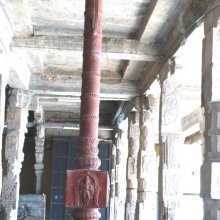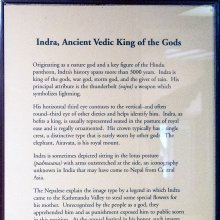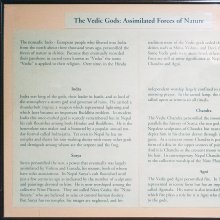Storm: 2 definitions
Introduction:
Storm means something in Hinduism, Sanskrit, the history of ancient India. If you want to know the exact meaning, history, etymology or English translation of this term then check out the descriptions on this page. Add your comment or reference to a book if you want to contribute to this summary article.
Images (photo gallery)
In Hinduism
Natyashastra (theatrics and dramaturgy)
Source: Shodhganga: Elements of Art and Architecture in the Trtiyakhanda of the Visnudharmottarapurana (natya)(Heavy) Storm is associated with Arāla-hasta: one of the twenty-two Single-hand Gestures (in Indian Dramas) (known as asaṃyuktahastas), according to the Viṣṇudharmottarapurāṇa, an ancient Sanskrit text which (being encyclopedic in nature) deals with a variety of cultural topics such as arts, architecture, music, grammar and astronomy.—The word arāla means bent or crooked. [...] In the Abhinayadarpaṇa, the arāla posture is said to use in the acting of drinking poison, nectar etc. Moreover, in this book to show the heavy storm, this posture is suggested to be used in Dance.

Natyashastra (नाट्यशास्त्र, nāṭyaśāstra) refers to both the ancient Indian tradition (shastra) of performing arts, (natya—theatrics, drama, dance, music), as well as the name of a Sanskrit work dealing with these subjects. It also teaches the rules for composing Dramatic plays (nataka), construction and performance of Theater, and Poetic works (kavya).
India history and geography
Source: Singhi Jain Series: Ratnaprabha-suri’s Kuvalayamala-katha (history)Storms during Sea-voyages in ancient India (known in Prakrit as: jattā, or Sanskrit: yātrā) were vividly depicted in the Kathās (narrative poems) such as Uddyotanasūri in his 8th-century Kuvalayamālā (a Prakrit Campū, similar to Kāvya poetry).—Accordingly, [...] On the return journey the greedy merchant pushed his friend in the mid-ocean and raised a false cry of his having slipped into the sea. The pious merchant after struggling for some time against the waves sank under the water and lost his life. He however became a Vyantaradeva who, in order to revenge himself against the mischief-making merchant, caused the storm leading to ship-wreck.—(Cf. Jāyasī 1527 A.D., describing situation of a storm and ship-wreck brought about by a Rākṣasa when Ratnasena was returning from Singhala).
A vivid description of the Storm is given consisting of rushing or gathering of clouds, dashing of waves, splashing of sea-monsters, etc. As a result the ship was tossed from side to side, the masts were broken, etc. In such a plight the men on the ship uttered prayers to their respective gods of motley pantheon, e.g., reciting a stotra to Nārāyaṇa, promising an annual sacrifice or offering to Caṇḍikā, a holy pilgrimage to Śiva and prayers to Mātṛkas, Sūrya, Vināyaka, Skanda, Yakṣa (probably Kubera), Revanta (the son of Sūrya), Buddha and others. Others vowed to feed Brāhmaṇas on their return. The ship was split into splinters and completely lost into vicious sea, the goods under water, and the sailors all died.

The history of India traces the identification of countries, villages, towns and other regions of India, as well as mythology, zoology, royal dynasties, rulers, tribes, local festivities and traditions and regional languages. Ancient India enjoyed religious freedom and encourages the path of Dharma, a concept common to Buddhism, Hinduism, and Jainism.
See also (Relevant definitions)
Ends with: Black storm, Heavy storm, Swartstorm.
Full-text (+312): Ativata, Jhanjhanila, Vatya, Reshman, Javali, Govardhana, Amdhi, Tuphana, Jaula, Jhanjhamaruta, Candavata, Varadalanem, Kadakavanem, Karakavassa, Phupavanem, Mahavata, Gagavanem, Kadakadanem, Ghengavanem, Avaskand.
Relevant text
Search found 160 books and stories containing Storm; (plurals include: Storms). You can also click to the full overview containing English textual excerpts. Below are direct links for the most relevant articles:
Brihat Samhita (by N. Chidambaram Iyer)
Chapter 38 - On Dust-storms (rajas-lakṣaṇa)
Chapter 36 - Signs of Aerial City (gandharvanagara-lakṣaṇa)
The civilization of Babylonia and Assyria (by Morris Jastrow)
Part IX < [Chapter IV - The Gods Of Babylonia And Assyria]
Part VIII < [Chapter IV - The Gods Of Babylonia And Assyria]
Part I < [Chapter IV - The Gods Of Babylonia And Assyria]
Heimskringla (by Snorri Sturlson)
Part 6 - History Of Hakon, Sigurd's Son < [Chapter V - Saga Of King Harald Grafeld]
Part 37 - Death Of Gudrod Ljome < [Chapter III - Harald Harfager's Saga]
Part 44 - Earl Sigvalde's Flight < [Chapter VI - King Olaf Trygvason's Saga]
Significance of the Moon in Ancient Civilizations (by Radhakrishnan. P)
4. The Moon and Weather < [Chapter 15 - Conclusion]
Aspects of Religious Belief and Practice in Babylonia and Assyria (by Morris Jastrow)



